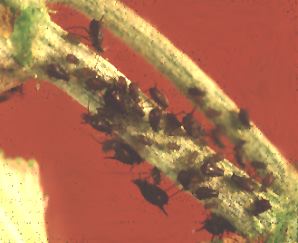
Grapevine aphid, Aphis illinoisensis (Shimer)
This is taken primarily from an
extension bulletin by D. G. Pfeiffer & P. B. Schultz, entitled
"Major Insect and Mite Pests of Grape in Virginia" (Va. Coop. Ext. Serv. 444-567 (1986))
The winter host of this aphid is Viburnum (black
haw). Winter is passed in the egg stage, mainly around buds. Eggs hatch in early spring over a 2-3
week period. A few parthenogenetic (reproducing without males) generations
occur before winged migrants leave for grapevines. Colonies of dark brown
aphids develop on young shoots and leaves (Plate 16, Fig. 10). When populations are high some may feed on fruit clusters, causing some berries to drop. In fall, winged individuals are again produced; these return to viburnum and produce males and females. The sexes mate and overwintering eggs are produced.
In 2002, grapevine aphid was found in Turkey, and in the years following was found in Greece, Israel and Tunisia.
This species is usually not important enough to necessitate specific treatments. Grapevines are of sufficient vigor to tolerate some attack and the aphids are subject to attack by predators (e.g., ladybird beetle adults and larvae, and lacewing larvae). Dry weather is conducive to buildups of aphid populations.
Back to Virginia
Vineyard
page
Back to Virginia Fruit Page
